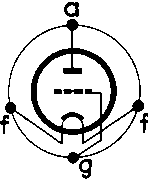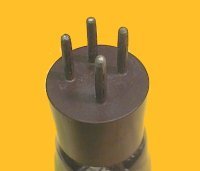
A.T.20
|
|
|||||||||||||||||||||||||||||||
|
Visite: 1944 Risposte: 3
A.T.20 (A.T.20) versus D404
|
|
|
Jan Terranea
12.Mar.14 |
1
The AT20 triode and the D404 share the same base-connection, B4, like most old european triodes. The D404, made by Philips, is a 10 watts audio-amplifier, heater voltage 4 volts, anode voltage 250 volts, while the AT20 is a 20 watts transmitting valve, heater voltage 6,3 volts, anode voltage 500 volts. These data are stated in Brands radio-tubes vademecum, 17th. edition. In my opinion the D404 should not be listed as a replacement for the AT20, nor does Brands equivalent radio tubes vademecum, 13th edition
|
|
Jacob Roschy
12.Mar.14 |
2
Hello Jan, I agree with you, to recomment the 10 watts D404 as a replacement for the 20 watts AT20 is a bad advice, hence I removed the D404. The BABANI tube encyclopaedia says 6 volts, 1 A as heater ratings. 6.3 volts was never used by European B4 tubes.
Best Regards, Jacob |
|
Jan Terranea
13.Mar.14 |
3
Dear Jacob, You are absolutely right about the heater voltage of 6 volts. I am sorry, the Avo-Valve-Data-Manual ed. 21, that I used to test the AT20, states the 6,3 heater volts Thanks for your correction. Jan Terranea
|
|
Michael Watterson
13.Mar.14 |
4
However a "6V" tube for Lead Acid Battery is really about 5.5V to about 6.8V operation. The 6.3V figure is derived as a nominal valuse for an in use Lead Acid Battery (perhaps in a car) not fully charged. 2V, 4V or 1.4V tubes similarly in use had an operational range, About 1.55V down to 1.1V for a 1.4V tube, though fresh with no load a Zinc cell may be over 1.6V it drops sharply. Similarly it drops quickly from 1.1V to the "official" completely discharged 0.9V. In practice only HT packs could usefully run from nearly 100V to about 55V (90V) or nearly 134V to 72V (120V). So are there any "really" 6V valves/tubes? What is the tolerance?
|
|
Visite: 1936 Risposte: 0
A.T.20 (A.T.20)
|
|
|
Jan Terranea
11.Mar.14 |
1
This AT20, Transmitting Triode 20 watts, was used in the British Wireless Set no.9, which was introduced in 1939. according to the compendium 1 of Wireless for the Warrior. This valve was renamed later on as CV1361. The commercial version produced by Mullard was named MZ05-20.
|
Fine delle discussioni nel forum su questo valvole
| Conformità dei dati | Ulteriori informazioni |



